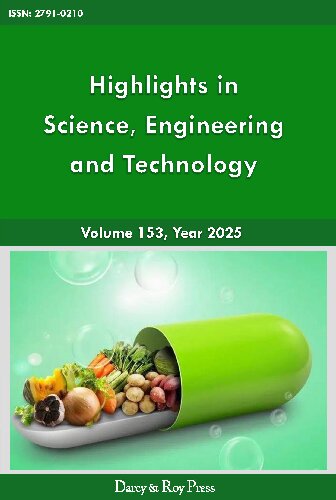JAK/STAT Pathway in Classical Hodgkin Lymphoma: From Pathogenic Mechanisms to Therapies
DOI:
https://doi.org/10.54097/ec9x9p62Keywords:
Classic Hodgkin lymphoma; JAK/STAT pathway; tumor microenvironment; immune evasion; combination therapy.Abstract
The JAK/STAT pathway is the primary mechanism for cytokine signaling and plays a pivotal role in classical Hodgkin lymphoma (cHL). The JAK/STAT pathway’s abnormal activation contributes to the development and maintenance of tumors. Both intracellular aberrant gene mutations and extracellular cytokine stimulation can continuously activate JAK/STAT pathway, promoting the proliferation, survival and immune evasion of Hodgkin Reed-Sternberg (HRS) cells, the tumor cells of cHL. Moreover, JAK/STAT pathway mediates the formation of an inhibitory tumor micro-environment (TME), as it can regulates the recruitment, differentiation, proliferation and function of various immune cells in the tumor micro-environment (TME) of cHL, including immune effector cells such as CD4+ Th cells, CD8+ T cells, NK cells and immunosuppressive cells such as myeloid-derived suppressor cells (MDSCs), tumor-associated macrophages (TAMs) and regulatory T cells (Tregs), with cytokines binding to corresponding receptors on the surfaces of these cells. Blocking the JAK/STAT pathway can impede the growth of HRS cells and modulate the overall activity of immune cells within the TME of cHL, suggesting that JAK/STAT inhibition might be a viable treatment option for cHL.This review will summarize the performance of JAK/STAT pathway in the pathogenesis of cHL, its effect on immune cells in TME, and the performance of JAK/STAT inhibition in clinical trials, while highlighting potential future directions for JAK/STAT inhibition in cHL treatment.
Downloads
References
[1] Ansell SM. Hodgkin lymphoma: 2025 update on diagnosis, risk-stratification, and management. Am J Hematol, 2024, 99(12): 2367-2378.
[2] Xue C, Yao Q, Gu X, et al. Evolving cognition of the JAK-STAT signaling pathway: autoimmune disorders and cancer. Signal Transduct Target Ther, 2023, 8(1): 204.
[3] Wienand K, Chapuy B, Stewart C, et al. Genomic analyses of flow-sorted Hodgkin Reed-Sternberg cells reveal complementary mechanisms of immune evasion. Blood Adv, 2019, 3(23): 4065-4080.
[4] Tiacci E, Ladewig E, Schiavoni G, et al. Pervasive mutations of JAK-STAT pathway genes in classical Hodgkin lymphoma. Blood, 2018, 131(22): 2454-2465.
[5] Lennerz JK, Hoffmann K, Bubolz AM, et al. Suppressor of cytokine signaling 1 gene mutation status as a prognostic biomarker in classical Hodgkin lymphoma. Oncotarget, 2015, 6(30): 29097-110.
[6] Camus V, Miloudi H, Taly A, et al. XPO1 in B cell hematological malignancies: from recurrent somatic mutations to targeted therapy. J Hematol Oncol, 2017, 10(1): 47.
[7] Seif F, Khoshmirsafa M, Aazami H, et al. The role of JAK-STAT signaling pathway and its regulators in the fate of T helper cells. Cell Commun Signal, 2017, 15(1): 23.
[8] Nagasaki J, Togashi Y, Sugawara T, et al. The critical role of CD4+ T cells in PD-1 blockade against MHC-II-expressing tumors such as classic Hodgkin lymphoma. Blood Adv, 2020, 4(17): 4069-4082.
[9] Cai F, Gao H, Yu Z, et al. High percentages of peripheral blood T-cell activation in childhood Hodgkin's lymphoma are associated with inferior outcome. Front Med (Lausanne), 2022, 9: 955373.
[10] Takahashi H, Ito S, Nakanishi Y, et al. Topological importance of CD8+ T-cell enrichment in the tumor microenvironment of classic Hodgkin lymphoma. Ann Hematol, 2025, 104(2): 1047-1057.
[11] Vari F, Arpon D, Keane C, et al. Immune evasion via PD-1/PD-L1 on NK cells and monocyte/macrophages is more prominent in Hodgkin lymphoma than DLBCL. Blood, 2018, 131(16): 1809-1819.
[12] de Haas N, de Koning C, Spilgies L, et al. Improving cancer immunotherapy by targeting the STATe of MDSCs. Oncoimmunology, 2016, 5(7): e1196312.
[13] Romano A, Parrinello NL, Vetro C, et al. Circulating myeloid-derived suppressor cells correlate with clinical outcome in Hodgkin Lymphoma patients treated up-front with a risk-adapted strategy. Br J Haematol, 2015, 168(5): 689-700.
[14] Solórzano JL, Menéndez V, Parra E, et al. Multiplex spatial analysis reveals increased CD137 expression and m-MDSC neighboring tumor cells in refractory classical Hodgkin Lymphoma. Oncoimmunology, 2024, 13(1): 2388304.
[15] Zak J, Pratumchai I, Marro BS, et al. JAK inhibition enhances checkpoint blockade immunotherapy in patients with Hodgkin lymphoma. Science, 2024, 384(6702): eade8520.
[16] Van Den Neste E, André M, Gastinne T, et al. A phase II study of the oral JAK1/JAK2 inhibitor ruxolitinib in advanced relapsed/refractory Hodgkin lymphoma. Haematologica, 2018, 103(5): 840-848.
[17] Gillessen S, Pluetschow A, Vucinic V, et al. JAK inhibition with ruxolitinib in relapsed or refractory classical Hodgkin lymphoma: Final results of a phase II, open label, multicentre clinical trial (JeRiCHO). Eur J Haematol, 2022, 109(6): 728-735.
[18] Kim SJ, Yoon DH, Kang HJ, et al. Ruxolitinib shows activity against Hodgkin lymphoma but not primary mediastinal large B-cell lymphoma. BMC Cancer, 2019, 19(1): 1080.
[19] Lee S, Shah T, Yin C, et al. Ruxolitinib significantly enhances in vitro apoptosis in Hodgkin lymphoma and primary mediastinal B-cell lymphoma and survival in a lymphoma xenograft murine model. Oncotarget, 2018, 9(11): 9776-9788.
[20] Weniger MA, Küppers R. Checkpoint blockade therapy in Hodgkin lymphoma: improved response through combination with JAK inhibition. Signal Transduct Target Ther, 2024, 9(1): 250.
[21] Ju W, Zhang M, Wilson KM, et al. Augmented efficacy of brentuximab vedotin combined with ruxolitinib and/or Navitoclax in a murine model of human Hodgkin's lymphoma. Proc Natl Acad Sci U S A, 2016, 113(6): 1624-9.
Downloads
Published
Issue
Section
License
Copyright (c) 2025 Highlights in Science, Engineering and Technology

This work is licensed under a Creative Commons Attribution-NonCommercial 4.0 International License.


















